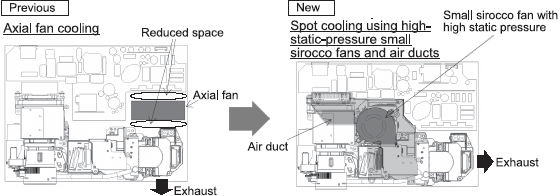Please note that JavaScript and style sheet are used in this website,
Due to unadaptability of the style sheet with the browser used in your computer, pages may not look as original.
Even in such a case, however, the contents can be used safely.
For the competition in the projector market, a compact and lightweight body becomes one of the important factors for selection, as well as high brightness and high resolution, for expanding the mobile use of projectors. However, the high brightness factor has a reciprocal relationship with the factor of a compact and lightweight body, since a high power lamp is generally required to achieve high brightness and then a large-sized cooling system is required for the high power lamp.
NEC Display Solutions Ltd. applies the small-sized air pump while improving cooling efficiency by reducing the packaging density in the unit, so that the size of the cooling system can be reduced to achieve higher brightness and a more compact body for the projector.
The lamp of the DLP projector employs an oval reflector. In this case, the beam concentrates at the top of the lamp bulb, and the top of the bulb becomes very hot. Thus, a cooling system with high velocity air is required. The ordinary projector uses the sirocco fan ventilating with the centrifugal force for cooling the unit. The sirocco fan must be installed near the lamp since its static pressure is low and an air duct must be provided. We apply the small-sized air pump instead of the sirocco fan. Since high velocity air can be sent through the tube, the cooling system can be installed anywhere, being a relatively dead space in the unit, even in a position far from the lamp, and the space within the unit can be used more efficiently.

For cooling the entire projector, the axial fan integrating the motor and the propeller frame is ordinarily used to ventilate the entire unit with a large amount of airflow. However, the axial fan has a low static pressure property, and the amount of ventilated air can be reduced drastically if there is resistance. Therefore, more space is required for ventilation in the unit. We employ spot cooling effectively by arranging three sets of the high static pressure and small-sized sirocco fan and the air ducts in the respective cooling positions, instead of the axial fan. With this method, some space can be reduced, and the packaging density in the unit can be improved.

By using this together with spot cooling in the unit, the cooling efficiency has been improved, and the size of the cooling system can be reduced. With the new cooling system, about 75% of the airflow required in the ordinary unit is sufficient for cooling the unit.
Cooling for the power supply: In the ordinary power supply, the heat sink for cooling is installed on the side where circuit board components are packaged. Thus, electric components installed close together interfere with the airflow sent to the heat sink part, then the cooling efficiency for the heat sink deteriorates. We install only some electric components generating a large amount of heat and the heat sink on the backside of the circuit board to improve ventilation efficiency and cooling efficiency.
Cooling for the DLP(R)chip: In an ordinary projector, the heat sink for cooling is installed on the backside of the DLP(R) chip, which is the display device for the DLP(R)projector and it radiates heat. We introduce a configuration where another heat sink for cooling is installed on the top side to radiate heat from the top side as well. With this configuration, the temperature of the DLP chip has been reduced by 5%.
Cooling for the housing: Since the lamp becomes very hot in an ordinary projector, the temperature of the exhausted air is very hot. Sometimes it reaches temperatures of around 90℃. Since the exhaust grid part (resin materials) is exposed to this hot air, it becomes very hot as well. In order to cool this exhaust grid part, we provide metallic materials on the inner surface of the exhaust grid to diffuse heat on the grid. With this arrangement, the temperature can be reduced by around 30%, so that it can be cooled with a small amount of airflow.
